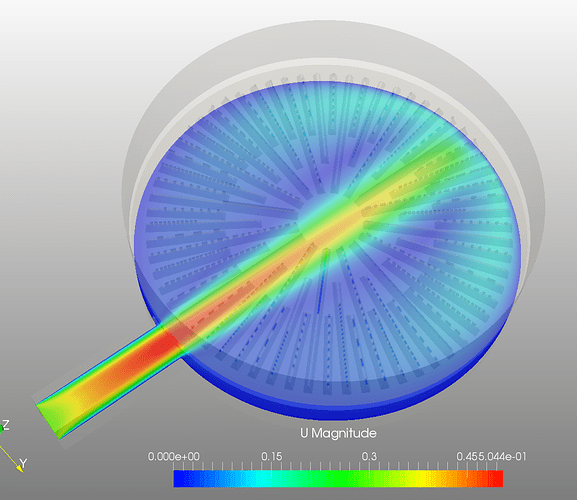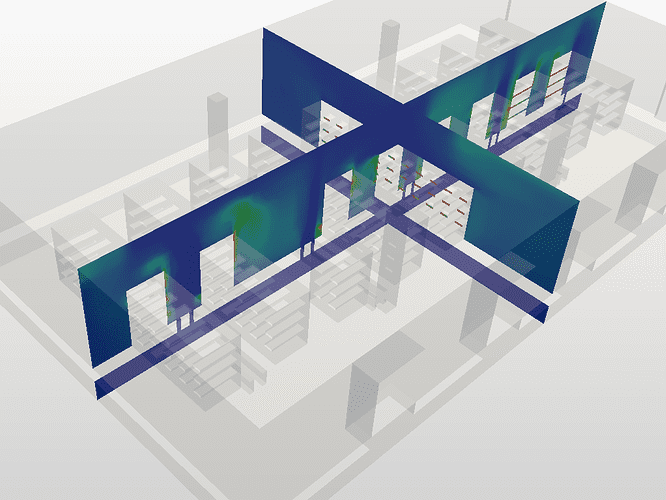Heating, Ventilation, and Air Conditioning or HVAC systems are an integral part of most working buildings, as well as a large proportion of homes. They are not only responsible for ensuring suitable ambient temperatures, but also for supplying air that is sufficiently clean and of good quality. Often overlooked, HVAC systems are important for maintaining good health and a comfortable working and living environment.

Filtration systems are an investment, so when a new building is being erected, or the HVAC system in an existing building need to be upgraded or replaced, it is important to critically evaluate the type of filtration systems available and determine which will be best suited for that building. This is, of course, also true in the case of car air filters.
There are many factors to consider when it comes to selecting the optimal system for specific scenarios. This is where simulations come into play.
HVAC Air Cleaner Design CFD for Air Filtration Optimization
Specific factors, as mentioned before, have a significant effect on the effectiveness of an HVAC’s air filtration system. Each of these factors (cleanliness, porosity, diameter, etc.) affects the fluid flow of the air through the air conditioning system (Read also: How to Design Better Air Conditioning Systems with Simulation), meaning that they need to be installed in such a way as to provide optimal flow.
CFD simulations rely on numerical and algorithmic analyses to investigate the issues that could arise due to restricted of inefficient air flows. They also provide suitable solutions to circumvent these problems should they arise.

There are numerous benefits of CFD simulation. You can actually read more about them in this article: CFD in HVAC Systems Applications. The system doesn’t require a physical setup, as everything is done using specialized software.
This software is powerful enough to mimic almost any physical phenomenon for which there is a mathematical model, and is capable of providing workable solutions after running a single engineering simulation. However, the system does require significant computing power and is best interpreted by someone with an extensive understanding of complex math, physics, and computer science.
SimScale is trying to tackle this issue by providing plenty of free webinars and learning resources and by optimizing the CAE software to be as user-friendly as possible. Furthermore, being cloud-based, users don’t have to worry about the computing power required, as simulations can be performed on a standard PC.
An air cleaner, in particular, benefits greatly from CFD because of the number of variables involved. For example, in the move towards greener buildings, optimizing airflow is critical to reducing energy waste and maximizing the use of natural flows to augment the system. Through CFD simulations, it is possible to plan the more advantageous placement, materials, and quantity of filters to ensure that clean air being delivered, and that its flow is not being hampered by inefficient air filtration.
With SimScale, you have the option to choose between laminar and turbulent models, based on the fluid flow Reynolds number, with solvers that support steady-state as well as transient setups and more.
Download this case study for free to learn how the SimScale CFD platform was used to investigate a ducting system and optimize its performance.
HVAC Air Cleaner Design Thermal Simulation to Reduce Energy Consumption
Temperature has a significant effect on the efficiency of the filtration in any HVAC system. These systems are affected by heat transfer, mass flow, velocity, the relationship between the pressure, temperature, and the matter state — gas or liquid — of the fluid within the system.
The quantity, dimensions, and layout of HVAC components, and, in particular, air filtration systems, are of critical significance to ensuring that the system is working at its most efficient. With the right simulation, factors like optimal pressure, mass, and flow direction can be successfully designed and implemented to optimize the effectiveness of the system.

A proper analysis makes it possible to not only understand the fluid flow but also to adjust it to reduce energy consumption, improve the positioning of machinery to optimize accuracy and precision, reduce noise emission, and decrease the burden on machinery to enhance its longevity and effectiveness over the lifetime of the system.
In the case of an air cleaner, thermal simulations can help plan the positioning, type, and quantity of filters. The strategic consideration of these factors facilitates optimal heating and cooling while reducing energy costs. For example, when installing an air cleaner into an office building, a simulation can indicate the best placement for it, allowing the optimal airflow to work areas at comfortable levels while also minimizing airborne particles and wear and tear on the filter. This, in turn, reduces the building’s energy requirements and costs.
A thermal analysis performed with SimScale can predict the behavior of your application or the structural response of a component based on thermal loads. Additionally, it can provide a deeper understanding of the heat flow through adjacent regions.
HVAC Air Cleaner Design FEA for Predicting the Longevity of an Air Cleaner and Parts
HVAC systems are, like everything else, composed of materials that have been processed and manufactured into the relevant components. Each of these materials has its own particular properties, including the air cleaners, as mentioned above.
Using the actual data of the air cleaner—such as their composition, thickness, porosity, etc.—FEA can, through a computerized CAD model, accurately predict the longevity of the product based on its reaction to real-world stressors, such as temperature fluctuations, pressure, fluid flow, vibration, and dirtiness.

FEA provides the user with accurate, safe renditions of the actual workings of the proposed system. The results are quite comprehensive, and a single model can be used to generate data on a variety of potential failures. With this method, one can simultaneously calculate and visually represent numerous parameters, including those mentioned above.
Using FEA when planning an HVAC system can allow the optimal materials for the components of the filtration system to be selected. For example, in a factory setting, it is vital to ensure a sufficient flow of clean, fresh air, while adequately filtering harmful particles. With FEA, it is possible to choose the most suitable filters to handle the particle load and estimate their useful lifecycle.
Therefore, finite element software for air filtration can use either natively single parts or complete CAD assemblies to help you understand the physical behavior of your system.
This free infographic illustrates how architects and engineers can use CFD to virtually test and optimize building designs and HVAC systems. Download it for free.
Selecting the right type of simulation for your project depends on the specific results you need to achieve. Do you have a heavy, medium or light filtration requirement? Is the focus on ensuring the longevity of air filters? Do you need a holistic view of the system to help with planning? Decide on what you need to investigate and try simulation with a free community account. It only takes 2 minutes to create an account.
And if you want to learn more about engineering simulation and real applications in air contamination cases, here are two blog posts worth reading:
Cleanroom Ventilation Improvement with CFD Simulation
Validating Ventilation for Smoke Control in Underground Garage with CFD




